P55 Overclocking Showdown - ASUS, Gigabyte, and EVGA at the OC Corral (Page 6 Updated)
by Rajinder Gill on November 6, 2009 12:00 PM EST- Posted in
- Motherboards
Gigabyte GA-P55-UD6
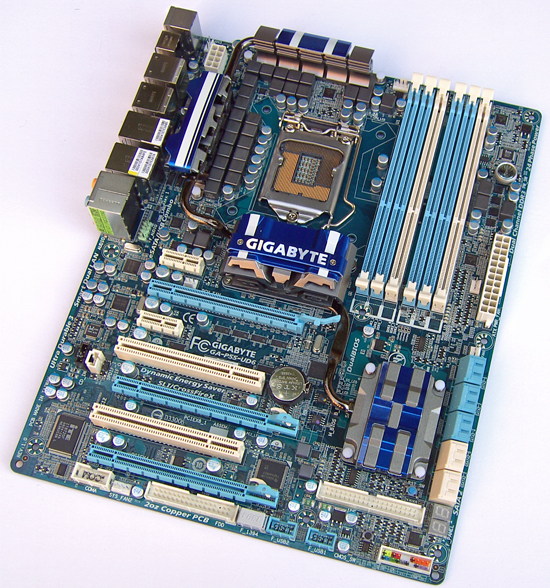
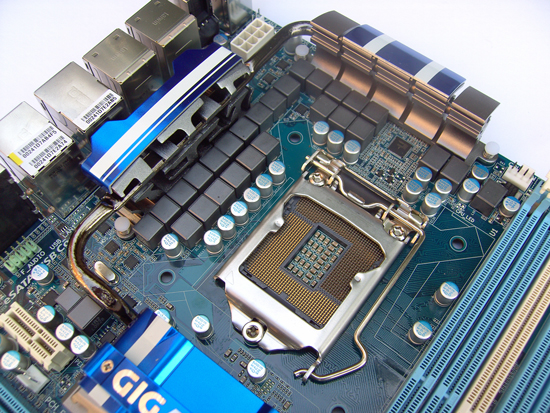
Gigabyte’s top end offering comes in at $250 and touts their answer to competing boards as having ’24-Phase’ PWM circuit (using a multiplexed ISL6336 6 phase controller). Onboard cooling of the MOSFET area, Intel P55 PCH , and Gigabyte SATA chips is provided by a heatsink/heatpipe setup connecting all three areas together. The PCH portion of the heat sink is attached with screws while the PWM MOSFETs and Gigabyte SATA chip fittings are of push-pin type (screw fittings are our favorites).
A total of 6 fan headers are available (two of which are 4 pin). Our retail sample came with a Foxconn CPU socket, although Gigabyte is moving to LOTES sockets on their upper end boards after hearing of the problems some users have experienced with the early Foxconn sockets.

Expansion slot layout is identical to the ASUS Maximus III ROG, which is a good thing in our opinion. Starting at the top, we’ve got a PCI/eX1 slot, followed by PCI/e X16 and then another CPI/eX1 slot immediately beneath. Moving down, we get a PCI slot, the second PEG slot (running at 8X) followed by the second PCI slot and finally the last 16x mechanical PCI/e slot (running at 4x width). Slot layout is good, allowing for a variety of peripheral cards to be used in tandem. Underneath the last PCI/e slot at the lower edge of the board, we have 1XCOM port, 1XFDD, 1X1394 and 2 x USB headers.
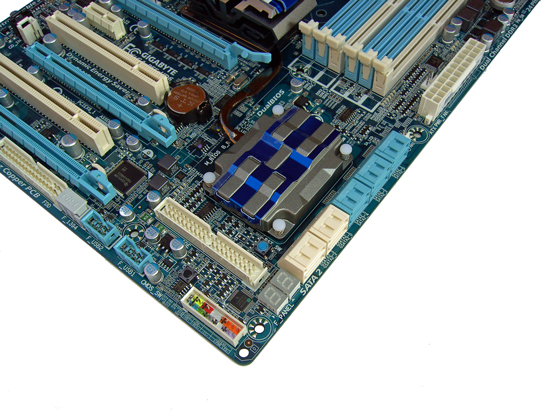
The lower right hand corner of the Gigabyte P55 UD6 is home to 10 right angled SATA ports (6 X Intel ICH10R and 4 Gigabyte SATA). A Hex post code reader is also included for debugging purposes. Just behind the Hex display, we’ve got CMOS clear and a reset switch for open test bed users. Finally an IDE port is provided for legacy drive users.
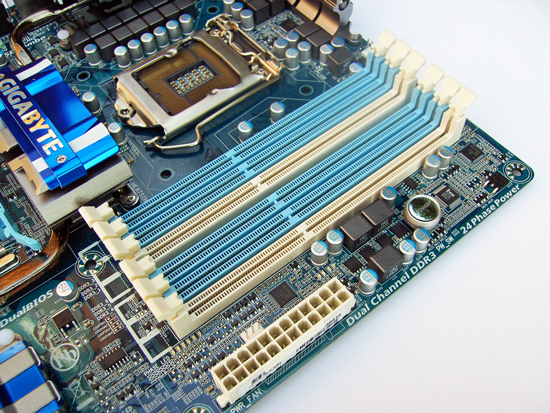
We’re a tad bemused at the presence of 6 DIMM slots on a P55 motherboard when the processors are dual channel only when run without buffered DIMMS. Oddly enough, the extra slots are for running single sided modules in dual channel interleaved mode over 6 slots. We’re not sure if this is a wise move at all because most users have moved over to double density 2GB modules which are priced attractively and capable of overclocking to high bandwidth due to advancements in memory IC design and memory controller design over previous platforms.
An onboard power button is placed very conveniently at the upper right edge of the board allowing for easy access in open test bed setups. Unfortunately, unlike the ASUS and EVGA boards, Gigabyte does not provide any voltage measurement pads for digital multimeters which can make the board a little tricky to get to grips with if you’re benchmarking under LN2.
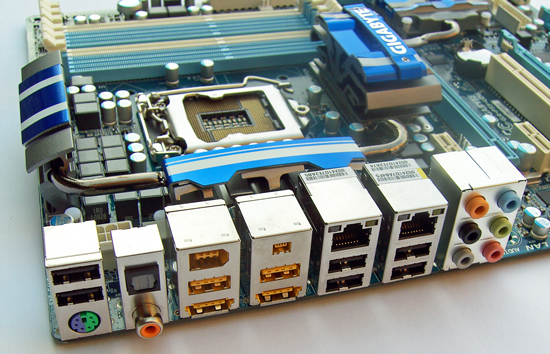
The rear panel is home to 1 x PS2, 8 x USB (2 SATA combo), 2 x1394, 1 x coaxial S/PDIF, 1 x TOSLINK optical, 2X RJ45 LAN ports and finally 6 audio output jacks. The presence of a rear CMOS clear switch would have been welcome for ease of access but is unfortunately missing. This leaves users with PC cases having to pull the side panel off their case if BIOS does not recover from a failed overclock.
Gigabyte’s Easy Tune software is bundled with the motherboard, and allows for easy access to all primary voltage rails as well as bus speed manipulation and fan control options.
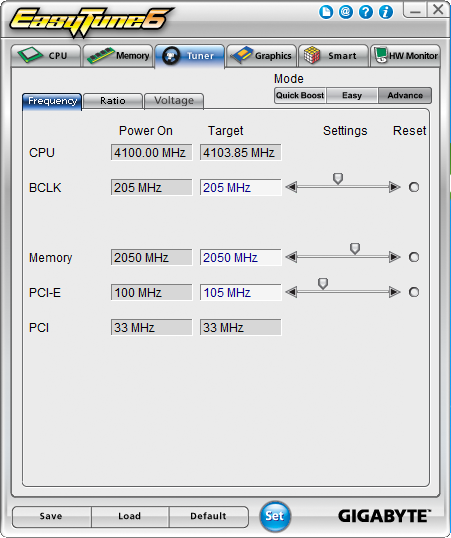
We found the Easy Tune software to be easy to use and to present a light enough system load to allow for unhindered overclocking. The only thing that would perhaps bolster Easy Tune would be the addition of hot keys with fast load profiles allowing for on the fly bus speed changes to maximize benchmark scoring potential. Other than that it’s a well rounded and easy to use tool.
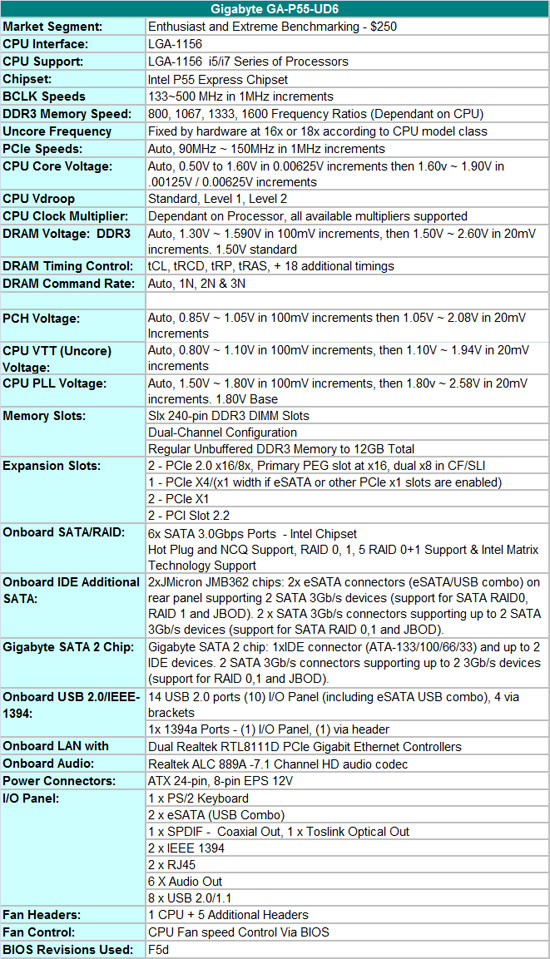
















52 Comments
View All Comments
spacedude - Thursday, January 7, 2010 - link
Just wanted to comment that I just ordered a EVGA P55 SLI (NOT FTW) from newegg and received a foxconn socket...Though on the forums, the evga reps are insistent that there is no problem with their boards.... Who knows if I even have a revised socket........
ARGHHHHHHH
johnyfriend - Tuesday, November 17, 2009 - link
Saw recently a number of boards from asus and gigabyte with Usb3 and Sata 6gb support.Are you guys planning to include those boards in your upcoming p55 board reviews?groove420 - Saturday, November 21, 2009 - link
The new Gigabyte boards will be designated as "P55A-UD6" for example, along with a "333" designation on the box.The feature that caught my eye on these is that they have been refitted with a LOTES clamp instead of the Foxconn.
They remain fitted with a Foxconn socket apparently though.
Whether the fix for the "hot socket" was just a better clamp, or indeed the socket is a revision as well remains an unknown from what I've gathered.
johnyfriend - Tuesday, November 24, 2009 - link
Think they went with the more afordable way to change the clamps than the entire socket.got to wait and see if it pays out..incase those who are willing to buy decide to dump $$$$$$$$ in thatArbie - Monday, November 9, 2009 - link
"Be warned the results are geared more towards benchmarking fanatics and are not in any way indicative of your everyday web browsing PC needs... "Is this a benchmarking fanatics website? Or is it aimed at folks who want high-performance gear for day-in, day-out use? I am in the latter group, which is why I visit AnandTech practically every day. But I won't even bother clicking through a report like this.
In fact, probably only 0.1% of your readers are going to build on the edge (sub-zero cooling?), and there are plenty of websites for them. I'd rather see the same time and effort spent on something more relevant to the other 99.9%.
My opinion...
dingetje - Monday, November 9, 2009 - link
fail troll, stop whining or go to tomshardwarematthewfoley - Tuesday, November 10, 2009 - link
I happen to agree 100% - I am interested in the high-performance gear for day-in, day-out use idea.Anybody who wants Lynnfield for breaking OC benchmarks is wasting their time.
dia - Tuesday, November 10, 2009 - link
99% of the articles here are for regular users. This happens to be an article that is not for everyone. So what's the big deal if the minority audience occasionally gets a hearing every now and again? When I see articles like this going up every single week I might start to ask questions, but not before that.AstroGuardian - Wednesday, November 11, 2009 - link
Guys and gals,This article is 100% for everyone despite what other ppl say.
You are totally missing the point of this post. This post is not about manufacturers and main boards. This post is about P55!!!
I am sure everyone (including benchmark fanatic) would like to hear about P55's capabilities. This article says about P55's abilities and gives insight about possible scenarios when pushing the P55 to its limits.
So what do you want to say? Do you criticize this site or what? Not all of you are IT professionals. As a matter of fact so few of you are IT professionals. And as professionals you musk know as much as possible about your area of expertise. I would like to know everything Anandtech has to say about everything. That's the beauty of it
cyclo - Wednesday, November 11, 2009 - link
+1. I rarely overclock myself but I still am interested in what the capabilities of this CPU/chipset combo are. I like seeing systems pushed to their limits until weaknesses become apparent. Extreme overclocking in my opinion is like stress testing... if there is any weakness in a design overclocking can expose it. In this case it could be the Foxconn socket, the lesser number of pins on the CPU itself (compared to previous gen i7s), the interface, or all of the above.